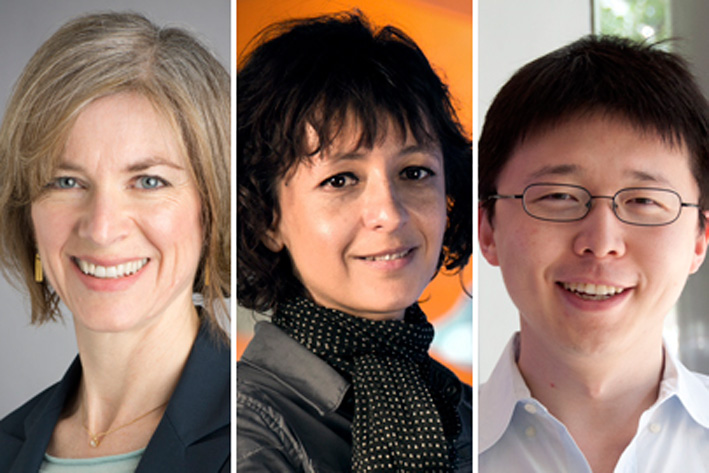Why Eric Lander’s Controversial Paper “The Heroes of CRISPR” Is Not Solid Historical Research
By Michel Morange
The rise of the CRISPR-Cas9 system was so rapid and ignited such a "craze." But how reliable is Eric Lander's historical description of "the heroes of CRISPR"?
February 17, 2016
Macroscope Biology Communications
The present fiery debate about the relative contributions of different researchers to the development of CRISPR-Cas9, the genome editing system that has been heralded with excitement among molecular biologists, is neither surprising nor new. The development of the polymerase chain reaction (a widely used technique for making many copies of DNA sequences) also generated a dispute. In my opinion, the conversation surrounding CRISPR-Cas9 would benefit from adoption of fundamental historical methods. By applying some basic techniques for tracking the progress of science, the interested parties would resolve some of the confusion and could potentially reduce bias from the process of determining noteworthy contributors.

The rise of the CRISPR-Cas9 system was so rapid and ignited such a “craze” among biologists that journalists started to propose names for the three (or fewer) future recipients of the Nobel Prize, thus exacerbating rivalries. And the outcome of the proceedings of the U.S. Patent and Trademark Office deciding who gets credit for the discovery, which are now under way, will have dramatic financial consequences for institutions and biotech companies.
The debate opposes Jennifer Doudna (and her institution, the University of California, Berkeley) and Emmanuelle Charpentier, who were the authors of the paper that demonstrated how CRISPR-Cas9 could be used as a genome-editing system, and Feng Zhang from the Broad Institute of MIT and Harvard, who was among the first to adapt the system to human cells and to demonstrate its efficiency. The three of them are the most cited possible future winners of the Nobel Prize.
Eric Lander, a founding director of one of the institutions involved in the patent battle, the Broad Institute, took part in the debate by writing a Perspective paper in Cell summarizing the backstory of CRISPR’s discovery, despite an obvious conflict of interest, and thus added to the turmoil.
This controversy does not mean that the work on CRISPR-Cas9 was not initially motivated by a desire to advance scientific knowledge, as Lander asserts in his review. Prizes and patents pollute the story and increase what is at stake, but do not, it is to be hoped, prevent curiosity from being one of the wellsprings of scientific discovery and innovation.
What is new and remarkable is the form that Eric Lander gave to his participation in the debate: the writing of a comprehensive history. Many readers have already pinpointed some problems with this historical record, in particular factual errors. The emphasis Lander places on those involved varies: Zhang’s work from his institute receives a full-page description, whereas the contributions of Doudna and Charpentier are much more briefly described. Rhetorical strategies, such as positioning in paragraphs, were also used to emphasize the value of some contributions over others. For example, Doudna is first mentioned in the middle of a paragraph, as the direct object rather than the subject of the sentence. Charpentier’s name appears at the bottom of a paragraph.
Another alleged strategy has also been pointed out by various readers: Eric Lander’s historical description is based on his study of publications, interviews, and notebooks, as well as letters of acceptance or refusal from the journals to which the articles were submitted. But the relative weight of these documents is different. For instance, the proportion of information from interviews and notebooks, which are inaccessible to readers, is higher in the case of Feng Zhang, thus supporting the idea of his early involvement in crucial research by implying that the dates of these materials precede publications by Doudna and Charpentier.
How reliable is this historical description of “the heroes of CRISPR”? The author’s intentions look good: to mention the names of researchers hitherto unacknowledged for their contributions and to describe the “ecological niche” in which these developments took place—a historian would say their context. Some have qualified Lander’s account as a “Whig history,” a term used to describe the writing of history as a political tool that glorifies the establishment and those in power. Applying this term to this situation perhaps lacks nuance, since his aim is not what is ordinarily considered as the main mark of this form of history—to justify present knowledge—but to evaluate the relative contributions of different participants.
Nevertheless, as a historian, I detect major flaws in the work of Eric Lander. The first is not to cite previous contributions to this historical description, a serious issue when one purports to give an objective description of what happened through the use of publications! Citing these works would not only have established Lander as a scholar aware of research addressing similar questions about CRISPR’s backstory, but would have helped him make cases for the discrepancies between them.
A second issue is that too much weight has been given to the content of interviews—not only because anyone involved has but a partial view of what happens in a scientific field at any time, which is inevitable and normal, but also because we know that human recall is fallible. Every scientist, indeed every person, spontaneously rewrites in their mind the history of the events that occurred. The late historian Frederic Larry Holmes wonderfully demonstrated this unreliability of memory in many different historical contexts, but in particular for the famous Meselson-Stahl experiment on DNA replication, for which there were no conflicts of priorities or patent disputes! Holmes was able to demonstrate to the scientists themselves that their description of how these experiments led to the semi-conservative model of DNA replication did not fit with what was written on the log sheets of the ultracentrifuges that they used for these experiments.
In addition, expressions used by Eric Lander do not correspond to the way scientific knowledge develops: through progressive construction in which, at the beginning, nothing is certain. For example, he says that “[Malcolm] Casadaban had immediately seen the importance of discovery in 2005 that CRISPR was likely to be an adaptive immune system....” Another example that focused on two of the main actors involved, Luciano Marraffini and Erik Sontheimer, further illustrates this point: Marraffini and Sontheimer are said to “have recognized that CRISPR was essentially a programmable restriction enzyme” as early as 2008. If this were the case, how can it be explained that two years later in a review published in Nature Reviews/Genetics, the same authors were so cautious? The proposition that it occurred through the action of a specific endonuclease was still one hypothesis, and not yet the firm knowledge that it would become two years later. For this reason, Lander’s historical description is clearly Whiggish: It is not appropriate to describe the growth of scientific knowledge as the progressive accumulation of solid bricks, each elaborated in a precise place as proposed in Figure 2 of his article.
One part of the inadequacy of this brick-by-brick model is that it omits the existence of alternative models—in this case, the hypothesis that bacteria have an interference system quite similar to that present in eukaryotes (Andrew Fire and Craig Mello received the Nobel Prize in 2006 for discovering this eukaryotic interference system). This hypothesis remained dominant up to the 2010s, and its influence is still visible in the article by Emmanuelle Charpentier published in Nature in 2011. A new model rarely emerges in a void, but has to oppose previous models and hypotheses.
Finally, Lander pays too little tribute to the progressive design of other tools for genetic engineering, such as meganucleases, zinc-finger nucleases, and then TALENs, and the first therapeutic application of these new tools at the end of the 2000s. The “CRISPR craze” would not have occurred without the explosive encounter between the work on CRISPR-Cas9 and the long (more than 20 years) line of research on meganucleases. CRISPR-Cas9 immediately found its place (at the top) among these tools, because it was much simpler to use and promised to be more specific. It was the unexpected convergence of research precisely oriented toward an applied goal—to be able to cut DNA at precise positions—and more exploratory research on the characteristics of a system existing in nature (without excluding applications such as industry’s protection of bacteria against invading bacteriophages): a wonderful example of serendipity.
There is one last issue that was not addressed after the protestations of Harvard geneticist George Church against the “preselection” of Nobel recipients or after the debate about Eric Lander’s article. Is it possible to select three names for the Nobel Prize? The true question is slightly different and probably more embarrassing: Is it possible to isolate three contributions and three scientists who, in receiving the Nobel Prize, garner recognition and prestige that will radically distinguish them from other scientists? Personally, as a historian, I am convinced that it was possible in the past. But is it still possible in present-day science, in which so many people among huge teams contribute to the advancement of knowledge, to select such a limited number of names? In some cases perhaps, but in others, such as genome editing, I think not. The present situation is also more complex because of the increasing habit of scientists to write patents: The preparation of a patent may alter the race to results between competing groups by preventing immediate publication and displacing a part of research time toward patent pursuit. Maybe now is the time for the Nobel committee and other awarding bodies to consider new and original ways to acknowledge important contributions to the growth of scientific knowledge.

American Scientist Comments and Discussion
To discuss our articles or comment on them, please share them and tag American Scientist on social media platforms. Here are links to our profiles on Twitter, Facebook, and LinkedIn.
If we re-share your post, we will moderate comments/discussion following our comments policy.